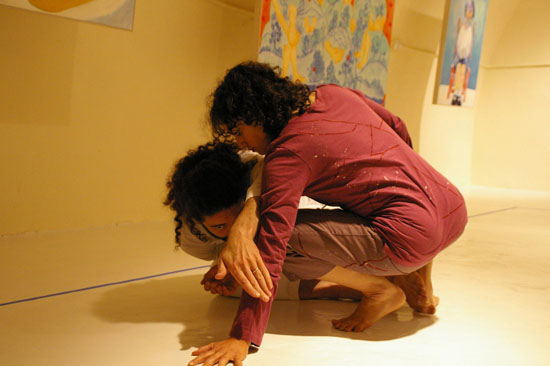The performers in Human Landscape Dance's "Closet Dances" are cramped. Each of the four dances depicts people stuck within the narrow confines of a walk-in closet. This closeness intensifies their relationships.
Closet Dances was performed at the Kennedy Center Millennium Stage on Wednesday March 23, 2011. Watch a video of this performance.
Malcolm Shute’s choreography emphasizes intimacy. Bodies mold together in unexpected ways: a leg stretched across a shoulder, a thumb pressing under a chin, or two bodies so entwined that one covers the other completely. The human dance of love, hate, parting, and supporting are played out in different degrees of touch. Each partner writes him or herself into the fabric of the other.
"Keeping Secrets," the first of the "Closet Dances," reveals lovers who are no longer honest with each other. They grapple or peel apart, unable to settle into an easy rhythm. With deliberate purpose, one grasps the other, only to lose his grip, limbs trailing behind as they part.
The second duet, "Hooked," reveals partners who both attract and repel one another. One grasps the wrist of the other, who heaves with her whole body to unhook herself. A tender stroke of the cheek becomes a violent push against the jaw. A kiss finally breaks the two apart.
The third duet, "Shadowing," depicts a friendship in which one friend overshadows the other. At first, we catch only glimpses of the meek friend, a hand or a face, behind the covering shape of her partner. She asserts herself more and more, sliding out from behind the shadow, finally standing between her partner and the light.
The intensity of the relationship accelerates the pulse of the movement in "Security Chain," the last of the "Closet Dances." Three dancers rush about within the closet, scurrying under, over, or around each other. They find many ways to catch upon one another, forming a chain. Yet this chain is habitually broken when one dancer or another, overwhelmed by the activity, flees the closet. Once a dancer steps outside the door, the tempo drops suddenly. They move at the pace of a sigh. The more the dancers try stay together, grasping one another tightly, the sooner someone else drops out. Ultimately, they seek new freedom outside the box.
The environment inhabited by the performers of "Closet Dances" contributes to the sense of overwhelming closeness embodied by the movement. The music that accompanies these dances is composed from sounds recorded in Washington DC: jackhammers, squeaks and whistles, the reverberation of metal on metal--raw noise from our streets. The outside world encroaches on the dancers, even shut up in their closet. The costumes reveal traces left on their bodies by the other dancers: fingerprints, scuff marks, grooves. Each feature reinforces the tension of close proximity.
"Closet Dances" are vignettes of relationships in conflict. Tenderness and aggression, desire and dread find their way into the movement. The intimacy of the relationships is reflected by the closeness of the partnering. The dancers are bound together, like lovers, by invisible strings.
